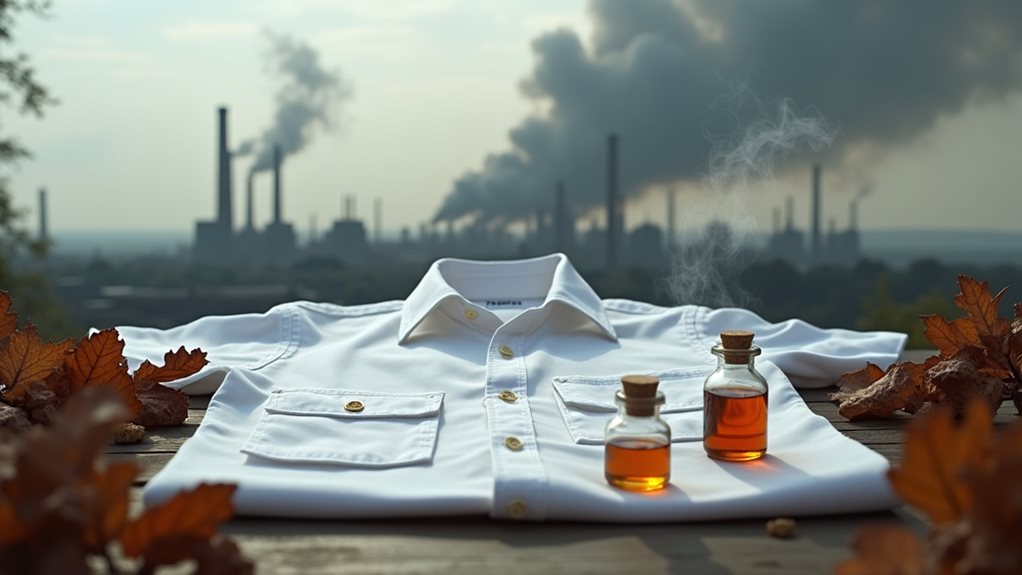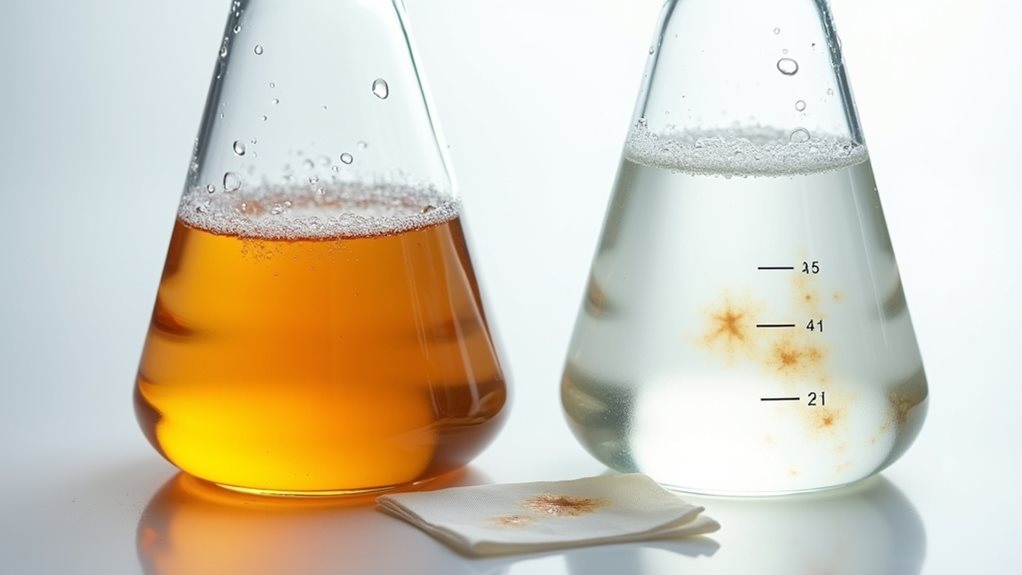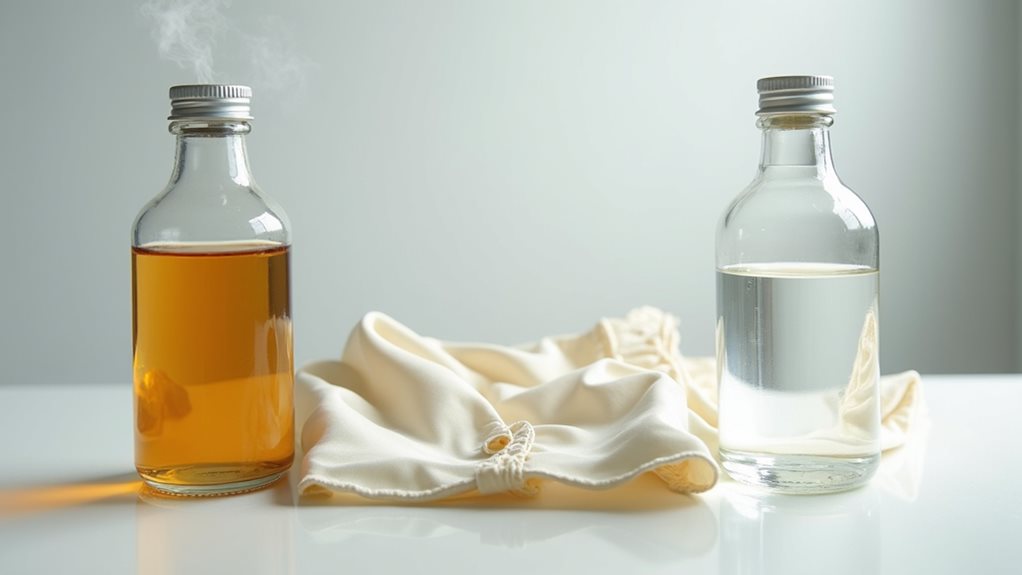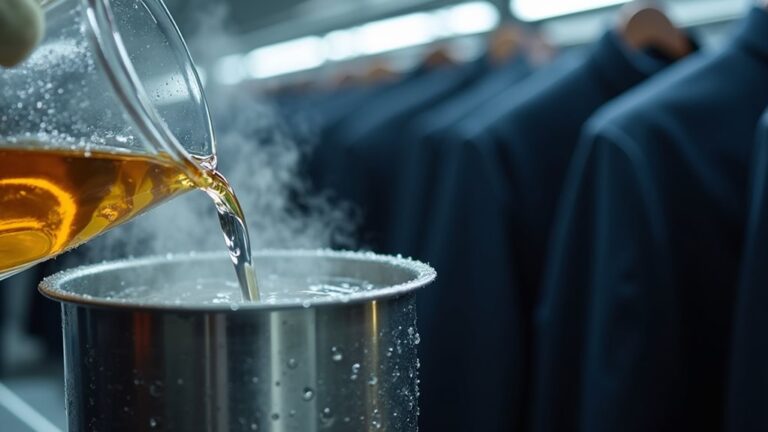While you technically could use petrol for dry cleaning since it dissolves oils and grease, I’d strongly advise against it – it’s like playing with fire, literally. Petrol’s highly flammable nature creates serious safety hazards, and those toxic fumes can damage your respiratory system while leaving harmful residues on your clothes. Professional cleaners abandoned petroleum-based solvents decades ago for good reason, moving toward safer hydrocarbon alternatives and eco-friendly methods that protect both your health and garments without the dangerous risks that come with understanding the full story.
Understanding Petrol as a Dry Cleaning Solvent
Although most people today associate dry cleaning with those mysterious chemical smells wafting from corner shops, petrol-based solvents actually pioneered this entire industry back when your great-grandparents were young.
Honestly, understanding this history helps explain why modern dry cleaning works the way it does. You’d be surprised to learn that petroleum dry cleaning was once the gold standard for removing stubborn oil-based stains, with these hydrocarbon solvents proving incredibly effective at dissolving grease and grime that water simply couldn’t touch.
However, the traditional dry cleaning process came with serious health and environmental considerations, as petrol qualified as a hazardous chemical due to its flammability and toxicity.
That’s why modern dry cleaning practices have evolved toward safer alternatives, prioritizing both environmental considerations and worker safety. Today’s industry has largely shifted to solvents like perchloroethylene (PERC), though even these chemicals present carcinogenic effects and require proper handling to protect both workers and customers.
Historical Use of Petroleum-Based Solvents in Dry Cleaning

When my grandfather first told me about his neighborhood dry cleaner back in the 1920s, I couldn’t believe the stories he shared about the overwhelming smell of gasoline that would hit you the moment you walked through those shop doors.
You see, petroleum-based solvents like kerosene and gasoline were the original cleaning agents in dry cleaning during the late 1800s and early 1900s. Things improved slightly when Stoddard solvent arrived in 1924, offering a less volatile option that tackled oily stains effectively.
However, after World War II, Perchloroethylene (PERC) revolutionized the industry with superior grease-cutting power. This chlorinated hydrocarbon became the industry standard because it could be recycled within the cleaning process and effectively dissolved oils and grease that water-based cleaning couldn’t remove. Yet growing health concerns and environmental impact led to stricter regulations, pushing the industry toward greener alternatives – something my grandfather would’ve appreciated!
Safety Risks and Fire Hazards of Using Petrol

While those old petroleum-based cleaners might’ve gotten the job done, the safety risks they posed were nothing short of terrifying – and I’m not being dramatic here.
You’re dealing with a highly flammable substance that’s fundamentally volatile gasoline, creating fire hazards that could turn your cleaning operation into a disaster zone faster than you can say “static electricity.”
The toxic fumes alone present serious health risks, causing respiratory problems and other nasty side effects for anyone breathing them in.
Then there’s the environmental pollution angle – spilled hydrocarbon contamination doesn’t just disappear, it seeps into soil and groundwater like an unwelcome houseguest.
That’s exactly why strict regulations now exist, because frankly, the risks far outweigh any cleaning advantages.
Modern dry cleaners have largely moved away from these dangerous petroleum solvents in favor of safer hydrocarbon solvents that provide effective cleaning without the extreme fire and health hazards.
Health and Environmental Concerns With Petrol Cleaning

Beyond the immediate fire dangers we just covered, the health and environmental fallout from petrol-based dry cleaning creates a web of problems that honestly makes my stomach turn when I think about all the people who were unknowingly exposed to these risks over the decades.
When you’re dealing with hydrocarbon solvents from petrol cleaning, you’re fundamentally inviting respiratory irritations, skin problems, and air pollution into your life.
The environmental impact hits even harder – soil contamination spreads like a nasty rumor, causing ecological damage that lasts for generations.
Plus, these harsh chemicals can fade and damage delicate fabrics, which defeats the whole purpose of professional cleaning in the first place! 😬
Similar to how traditional dry cleaning chemicals like PERC can leave harmful residues on clothing, petrol-based cleaning methods present comparable risks where chemical residues can remain on garments long after the cleaning process is complete.
Modern Alternatives to Petrol-Based Dry Cleaning

Since the dry cleaning industry finally woke up to the nightmare that petrol-based solvents created, we’ve witnessed an incredible transformation toward safer, more effective alternatives that honestly make me breathe a sigh of relief every time I drop off my favorite wool coat.
Modern dry cleaning methods now incorporate hydrocarbon dry cleaning, which treats your delicate fabrics like precious silk rather than garage rags.
You’ll find eco-friendly cleaning options replacing the old Perchloroethylene (Perc) chemical solvent that regulators rightfully banned.
Wet cleaning techniques can tackle both water-based and oil-based stains without harsh chemicals, while liquid carbon dioxide and silicon-based environmentally friendly solvents represent cutting-edge innovation.
These advanced solvents effectively dissolve oils and grease that traditional water-based washing simply cannot remove.
Each cleaning method prioritizes your health and our planet’s wellbeing 🌍.
Why Professional Cleaners Avoid Petrol Solvents

When I first started researching why my neighborhood dry cleaner switched from petrol-based solvents to safer alternatives, I discovered that professional cleaners treat gasoline like a ticking time bomb in their shops, and honestly, I can’t blame them one bit.
These petrol solvents are incredibly flammable, creating serious safety risks that could turn a routine cleaning day into a disaster.
Beyond the fire hazard, I learned that these solvents can absolutely wreck delicate fabrics, causing colors to fade faster than my summer tan.
Professional cleaners also worry about environmental concerns, since petrol contributes to air pollution and creates health risks from toxic vapors that nobody should be breathing daily.
The industry has been moving toward safer options like liquid CO2 and hydrocarbon solvents that don’t pose the same extreme risks to workers and customers.
Choosing Safer Dry Cleaning Methods for Your Garments

When you’re standing at the dry cleaner’s counter clutching your favorite silk blouse, you’ll want to ask specific questions about their solvent choices, because different fabrics respond dramatically differently to various cleaning chemicals.
I learned this the hard way when my grandmother’s vintage wool coat came back looking like it had survived a small tornado, simply because the cleaner used an overly aggressive solvent that stripped the delicate fibers.
Beyond protecting your wardrobe investment, you’re also making an environmental choice that extends far beyond your closet, since eco-friendly solvents reduce harmful chemical runoff that affects local water systems and air quality.
Traditional dry cleaners often use perchloroethylene (PERC), a toxic chemical solvent that can pose serious health risks including potential carcinogenic effects and nervous system damage for both workers and customers.
Fabric-Specific Solvent Selection
Although I learned this lesson the hard way after shrinking my favorite cashmere sweater 😅, choosing the right solvent for your garments isn’t just about getting them clean—it’s about preserving the fabrics you love while keeping yourself and the environment safer.
You’ll want to take into account fabric sensitivity when selecting solvents, as delicate materials like silk and wool benefit from gentler hydrocarbon solvents that won’t cause damage or color fading.
However, if you’re dealing with stubborn oil-based stains, perchloroethylene (Perc) might be necessary for effective removal.
For a gentler approach, eco-conscious consumers can explore solvent options like siloxane or liquid CO2.
Always check garment care labels to verify your fabric composition aligns with the chosen solvent.
Understanding why water cannot be used for certain garments helps explain the necessity of these specialized solvents in professional fabric care.
Environmental Impact Considerations
Because environmental consciousness has become as essential to my daily decisions as checking the weather before leaving home, I’ve discovered that choosing safer dry cleaning methods isn’t just about protecting our planet—it’s about making smarter choices for our wallets and wardrobes too.
When I learned about petroleum-based solvent environmental impact, including flammability risks and groundwater contamination, I realized my favorite silk blouse deserved better.
Consumer demand has pushed the industry toward eco-friendly practices, and honestly, I’m grateful for these regulatory changes.
While perchloroethylene has dominated the dry cleaning industry for decades due to its superior cleaning properties, health and safety concerns are driving the transition to more environmentally friendly alternatives.
Here’s what I’ve learned about gentler alternatives:
- Hydrocarbon solvent options protect delicate fabrics while reducing environmental harm
- These methods are gentler on fabrics, preventing the color fading I experienced with traditional solvents
- Eco-friendly practices often extend garment lifespan, saving money long-term
Your clothes—and our planet—will thank you!




